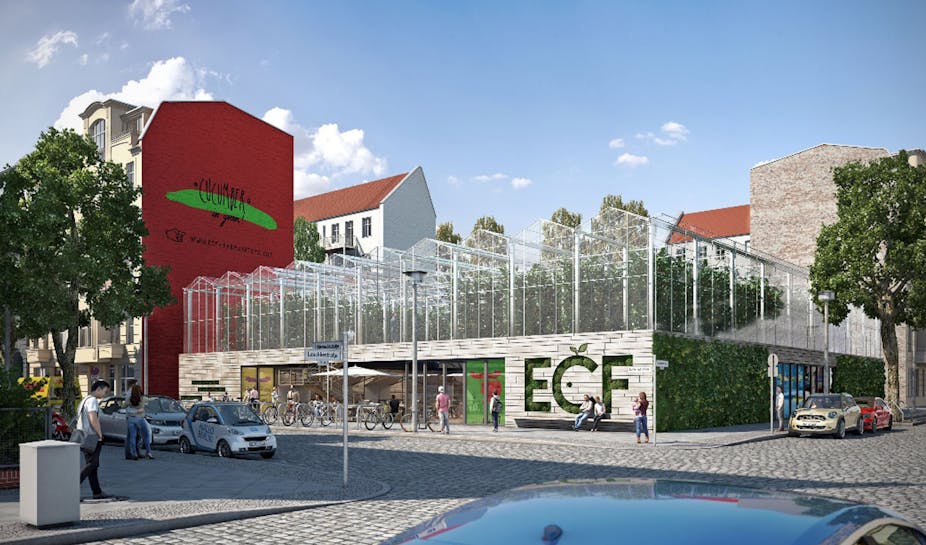This article was co-written with Alexis Figeac.
The term waste describes materials or products that are no longer of use. In a linear economy, it accumulates as an undesired by-product of economic activity. Waste and environmental hazards are commonplace throughout the current industrialized food system. Although some initiatives have been aiming to reduce waste toward the end stage – for example, by changing consumer perceptions and matching excess supply with demand – significant progress needs to be made during food production. Where do we start?
Redesigning production and consumption
One idea that has been growing in both research and practice is the circular economy, which sees value in “waste” flows and re-routes them back into the economic process. A striking example of a circular-economy business model in action is aquaponics, which combines elements of aquaculture (fish farming) and hydroponics (plant farming with controlled systems). It allows a single producer to sustainably grow produce and raise fish within the local community.
While traditional aquaculture is performed in structures within a natural environment, aquaponics adopts the circular-symbiosis approach, where the biological waste of a fish farm is harmonised to be the biological food for the production of plants such as herbs, salads and tomatoes. Compared to traditional industrial farming operations, where circularity might be added at the end (for example, compost), aquaponics employs a circular production design by leveraging nature’s template. This is a balancing act to technologically control two separate but dependent biological systems, which improves the productivity of the physical space – in this case an urban environment – while reducing environmental impacts.
Aquaponic firms leading the way include ECF Farmsystems and Stadtfarm in Berlin, BIGH Farm in Anderlecht, Urban Smart Farm in Gent and Bioaqua Farm in Blackford, United Kingdom. They’re among a growing number of urban-farming pioneers that challenge the way we perceive, produce, and purchase our food.
A better solution
How these benefits are derived can best be understood by a comparison with traditional aquaculture systems. In these cases, fish produces high levels of nitrates and phosphorus, which must be purged from the system and replaced with fresh water to maintain healthy living conditions. However, by flushing this nutrient-rich fish wastewater into the environment, ecosystems may be damaged by eutrophication. In urban environments, it imposes costs for treatment through municipal sewage systems. Furthermore, these same nutrients are required for plant cultivation – and in the case of nitrates – they are commonly derived in an industrial process that requires significant quantities of methane gas, must be shipped to the farm, and are often (over)applied to crops.
An aquaponics system takes the would-be waste output of highly nutrient water and delivers it directly to plants, cleaning it and reducing this dependence on added fertilizer. The water is maintained in the system, continuously circulates and is cleaned mechanically and biologically. It effectively reduces water needs – advanced aquaponics systems achieve up to 90% higher water efficiency than traditional field farming – as well as reducing the dependency on fossil fuel for transportation, because production is close to the markets for the final food products.
“Food miles” are not only a contributor to GHG-emissions but they are also part of a phenomenon of anonymization of food production, detaching the consumer from its source. Sustainable urban farming through aquaponics thus brings food production closer to its consumers. While urban farming is primarily a source of plant-based fibre, vitamins and minerals, aquaponics is able to deliver the missing dietary link, animal protein. Indeed, aquaculture is far more efficient and practical in this respect than other forms of livestock breeding in urban environments. Furthermore, it has the added social benefit of bringing advanced farming jobs to urban areas.
Challenges of aquaponics
Thus far, aquaponics businesses operate in a vague policy environment that falls under both aquaculture and agriculture, resulting in a web of bureaucracy. At the EU level, aquaponics is not regulated as a distinct sector, and regulations are therefore less than ideal. This filters down to the local level, where major challenges faced by aquaponic operations concerning zoning, planning and permissioning. Surprisingly, ECF had struggled to have its greenhouses approved on what is currently an industrial sector – there are rigid definitions of what industry, agriculture and food production are, limiting the integration of such innovative concepts.
Furthermore, to assess the sustainability of any process, one must consider all inputs and outputs. For aquaponics, while there is potential for significant environmental benefits, a major challenge is obtaining sustainable fish feed. Most is derived from soy or animal products with significant environmental impacts themselves. Furthermore, some feed components aren’t ones that the fish species would find in its natural environment and thus aren’t needed. Developments in insect-based feedstock might be a solution to many environmental concerns.
Moving beyond a niche market
Despite these challenges, ECF and other aquaponics advocates, believing in substantial benefits for society, continue to expand and seek out regulatory changes, signalling hope for the new market.
The concept of aquaponics provides insights into how circularity could be approached and ease the challenges of global population growth – with a need for sustainable food, free of herbicides, pesticides, hormones, antibiotics, and microplastics, that considers urbanization, food transportation, clean water scarcity, and environmental hazards related to traditional farming, eutrophication and carbon emissions in particular. Beyond these benefits, urban farming may also help green our concrete jungles and have further environmental and psychological benefits.

